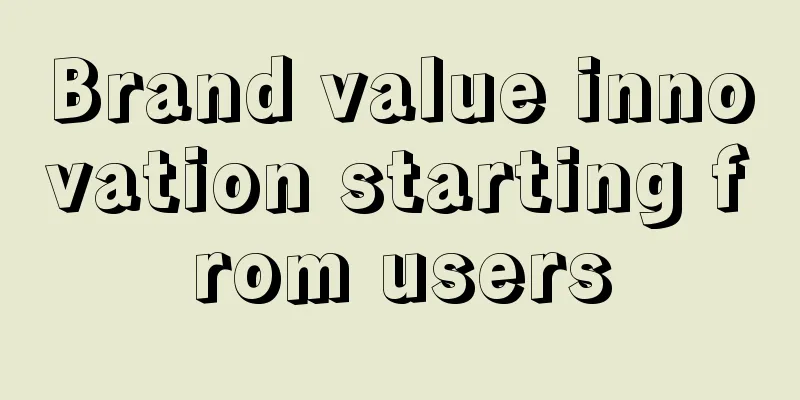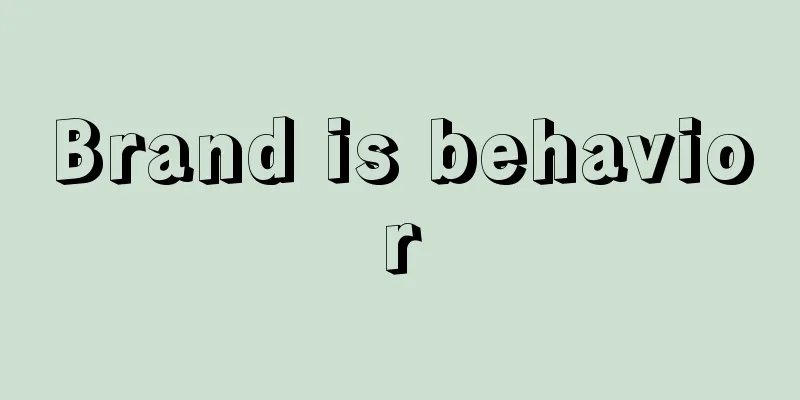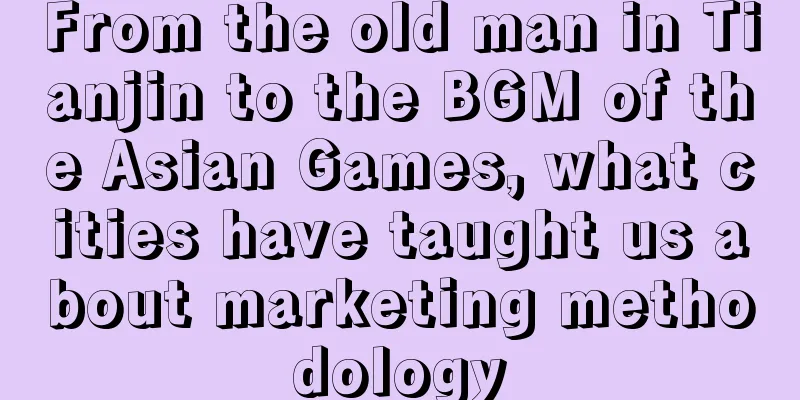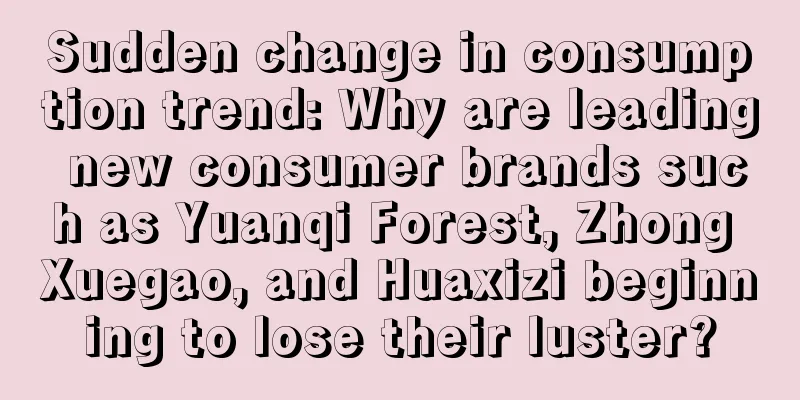Brand value innovation starting from users

A starting point with innovative value often comes from why you want to do something. Brands that blindly follow others are prone to fall into confusion and anxiety, while brands that can see themselves and the market clearly will still have a bright beacon. Judging from the customer inquiries and commissions Mushan has received this year, most brands are no longer satisfied with building a complete, standard and beautiful brand system. What they need more is brand innovation to provide users with stronger core value. There are two ways to innovate brand value from the user’s perspective: One is to meet user needs, and the other is to create user value. This is not a new trick, but in the current environment where it is easy to get lost, we need to go back to the original starting point to think about innovation. This article will try to explain these two modes of operation clearly. Originally, in my and my friends’ cognition, “starting from the user” should have been a deeply rooted concept, but recently we have seen that this is not the case. There are still many brands that are still self-centered and stagnant. So let me start with some negative examples. 01 If a brand is self-centered, everything will be meaninglessThe business and brand world we see every day under the new brands and new ideas reported by various media is not real. We originally thought that most brands already had a thorough understanding of "user experience, product innovation, and brand value" and used this as a guide for their work, but this is not the case in reality. This may be because we are misled by the "branded atmosphere group" created for us by 10-20% of advanced and emerging brands. The vast majority of Chinese brands, 80% of the products you come into contact with in your daily life, have not changed much. Perhaps because of channels, wealth accumulation, or perhaps just because of "arrogance", they often don't consider users much, but think more about themselves. 1. The arrogance of new brandsA few weeks ago, we experienced a new brand of Hunan freshly-fried fast food. Not long after the brand was established, it basically fell into a state of "making itself comfortable but not making users comfortable." The average cost per person for this restaurant on Dianping is 67 yuan. The overall experience and the brainwashing welcome message at the door make us a little confused about the positioning of this restaurant. Is it to be a fast food restaurant with low prices, or to be a simple meal of freshly fried Hunan dishes with a quality experience? Because it is neither cheap nor a quality experience. The restaurant doesn't care about its customers and there are really few customers during peak hours. We will not go there again. In fact, catering brands can achieve a balance between user experience and revenue. The key lies in whether the brand thinks it is important. 2. Thinking of classic brandsCoincidentally, we also found a similar problem when we were doing an offline survey of a classic brand. One of the brand's flagship stores was next to Huaihai TX, one of the gathering places for young people in Shanghai. It had a very good market, but few young people passing by the door were willing to come in. Walking into the store, I felt like I was back in time to a state-owned factory store more than a decade ago. The items in the store were disorganized and had no focus, and I couldn't feel the history and heritage of the classic brand at all. The waiter just wants you to buy and leave quickly. We tried to learn about the signature product and planned to order 2 to try. The waiter directly said, "Three people, right?" (without asking in a questioning tone), and then started packing the food into the cups according to the number of 6. I quickly said that I would only buy 2. But when I said this, I actually felt that the user experience was very bad, as if he thought I couldn't afford 6? We looked around and planned to buy another product, so I asked the waiter to get me one. Maybe it was because of me, I didn’t see the price clearly. When I paid, it was 48 yuan, and the whole box was a single item of the same type. Other stores also have similar problems. Products that can obviously be sold individually or in small portions are packaged in large bags and priced at 40+50+, which makes you feel that you cannot finish them physiologically. The products are very repetitive and not cost-effective. When we go to a store to do research, we usually take some photos of the scene for record, but the waiter came over and stopped us, saying that taking photos was not allowed. This is a classic baking brand with a long history, and a taste memory for a generation. But now the turnover has dropped from 20,000 to a few thousand. On the surface, it seems to be a problem with the waiters and product design, but what is behind it is the brand's emphasis on user needs. The waiters only want to complete sales, rather than allowing customers to have a comfortable experience in the store and complete purchases spontaneously. As baking brands, such as Hutouju and Shanhai Tea, although they did not perform well in all dimensions, they did meet some of the needs of contemporary consumer groups. Classic brands are now popular and are also "trendy" brands that meet current consumer demand. But users have changed, and their demands have changed accordingly. The new brands’ understanding of users is not in the same dimension as yours, but you are immersed in the past, self-centered, and unable to see the essence of current changes, you will easily be abandoned by the times. "Old" is not the problem, "outdated" is the problem. Old brands only have history, but old tastes are aesthetics, viewpoints, and sales methods. Every brand, no matter new or old, has some belief when it is first established, such as "I want to bring some value to users or society". However, on the road of entrepreneurship, they are distracted by too many things. Some brands gradually lose their original beliefs and finally achieve the opposite of what they expected. 02 What is satisfying user needs and creating user value?Rather than saying they are two different approaches, they are two different modes of thinking. Both start from the user and think about what value I will ultimately bring to the user. Neither is better or worse. When we talk about products meeting user needs, what we are actually saying is: conduct strategic demand analysis and judgment based on research results on competitors, markets, sales data, and user needs. Teams that are good at this type of thinking often like to study various brand strategies and business models. They are very sensitive to market demand, business opportunities, and category pain points. They are good at integrating supply chain resources so that products can be quickly iterated according to changes in demand. The core of this approach is comparison and competitive thinking. Through analysis and research, we can find categories, price gaps and user needs that have yet to be met, make the smallest MVP product at a faster speed, then quickly put it on the market, seize the market, and then gradually iterate. Typical brands include: Yuanqi Forest, Pop Mart, Wonderlab, Jane Eyre, etc. Creating user value, although also starting from the user's perspective, is more like an artist creating a product. The core is subversion and creative thinking, which often leads to brand new products or definitions. Although this type of team also looks at the market and conducts user research, they do not completely follow the current market conclusions and frameworks. They have some "self-centered" understanding (closely related to the team members' lifestyle and work experience). This self-centeredness may not be popular, but they believe that this is what users need. The core of this approach is creative thinking. Through years of insight into users and market judgment, combined with one's own aesthetics and experience, users or products are re-understood or defined, and products and brands are created by breaking out of stereotyped thinking, or a new user demand or scenario is created, often with a pursuit of perfectionism. For example: Heytea, MUJI, etc. The obvious difference between these two methods is that the former often uses a better product or expression to meet the needs, while the latter has the chance to create a product or scenario that has not yet appeared in the industry. If we use strategic theory to make a distinction, the former is more like positioning, category strategy, and competitive strategy, while the latter is more like blue ocean and cultural strategy. The purpose of giving examples and making distinctions between brands is to facilitate understanding of the two ways of thinking, not to deliberately separate the two brands. In fact, many brands have completely different practices at different times and stages, and the two approaches may intersect and merge. But the ultimate goal of all approaches is to become a brand that is valuable to users or society. 03 Two operational paths for brand value innovationFor brands that meet user needs, the most core ability is often to understand market demand and then quickly scale up. 1. Discover unmet needs and occupy the high ground in the category through "scale, speed, display, advertising, channels, etc."For example, Pop Mart started out as a fashion toy and lifestyle store, but from its own and competitors’ store data, Pufang and Cool Toy, it was found that Sonny Angel series IP blind box products accounted for 30% of sales in 2015, with a very high repurchase rate, and they are addictive and highly profitable. Sonny Angel is a Japanese brand, and its localization speed is a bit slow, which gave Pop Mart, with its unique vision, time and category gaps. Therefore, Pop Mart obtained Molly’s IP license in April 2016 and introduced the blind box gameplay, starting its transformation into an IP incubation operator and becoming a pioneer of China’s trendy toy culture. Everyone knows the rest of the story. Maybe even today, many friends still think that SonnyAngel is the original first, but there is always someone who can meet consumer needs faster than you. I personally like Smiski Corner under Sonny Angel. It could be bought at Pufang in the early years, but later it could only be bought online because the market share of offline blind box toys was seized by Pop Mart at a tornado speed. The core ability of Pop Mart to meet user needs is not the original blind box, but the strong IP operation ability, and the ability to quickly integrate design, supply chain and channel resources after discovering opportunities, and then to form a platform capability at the retail terminal. It has infinitely magnified the business model of blind boxes and brought it to all consumers. 2. Through market and user insights, optimize the expression and presentation of products and selling points, or create concepts, reverse product development, and achieve brand value innovationWonderlab's earliest "milk tea-level meal replacement taste" and Jane Eyre yogurt's "short ingredients, 0 additives" both belong to this category. Meal replacements themselves are anti-human products. In order to solve this problem and make it easier for users to accept this healthy way of eating, the brand found inspiration from addictive and popular milk tea, and used this as a concept to adjust the palatability and change the taste. By leveraging the user's perception of "milk tea", users can "feel" that it tastes better, greatly lowering the purchase threshold. In addition, the use of fashionable "little fat bottle" packaging changes the "professionalism and scientificity" of the meal replacement itself, making the experience fashionable and making users happy to show off their eating habits, thus breaking the circle. In this way, Wonderlab allows more people to experience another healthy way of eating. Wonderlab has made less noise this year. Perhaps the biggest challenge for it is how to continue to create new concepts and continue to lead consumers to choose functional health foods. Jane Eyre yogurt makes consumers feel safe and trusted on the basis of friendly prices. Friends who have followed Le Chun’s development should be familiar with this picture. In terms of products, Jane Eyre chose healthy, low-sugar/sugar-free, and additive-free yogurt, while Le Pure focused on additive-free, high-protein, filtered whey yogurt, firmly grasping the market demand of consumers for high-quality products. In its early days, Le Chun did attract enough fans and satisfied the needs of urban white-collar workers for high-quality products, but due to its high price: about 16 yuan/135g, it was unable to serve more users. Jane Eyre's pricing: about 8 yuan/135g, meets the comprehensive needs of most mid-range users in terms of price, safety, simple ingredients and taste. So first of all, Jane Eyre saw the gap in price and demand. The price of ordinary yogurt on the market is basically around 3-6 yuan. Even if the yogurt at this price range is produced by Yili, Mengniu, and Guangming, their products do not meet consumers' demand for "additive-free, pure, low-sugar" yogurt. Most of them are still "flavored fermented milk", which are flavored yogurt drinks containing food additives. In addition, it is no exaggeration to describe the yogurt market at that time as fancy and overwhelming. Various functions, new concepts, additives, imported and domestic products, scenarios, etc. made it difficult for you to choose on the shelves of supermarkets and convenience stores. But what most consumers really want is a cup of good yogurt that is healthy, pure and trustworthy. In response to the demand, Jane Eyre takes "short ingredients, 0 additives" as the core concept selling point, which runs through the entire brand name, language, color, and packaging, so that consumers can better understand itself. Therefore, Jane Eyre better meets the needs of its corresponding group of consumers in terms of price, quality, and brand expression. When writing this, I found that the insights and strategies of Jane Eyre and Manner Coffee are similar, which I will not elaborate on here. For brands that create user value, the core capability is often to re-understand and redefine categories and industries, create highly differentiated products, and allow users to actively seek out the brand. 1. Train your thinking to redefine and understand categories, users, products, and scenarios, and try to break the existing frameworkLast year, a speech video by Brian Collins, founder of the American brand consulting and design company Collins, had a great impact on me. The speech included some different understandings of the design industry, and the final lipstick project was a redefinition of the category. In terms of design thinking, he does not follow the general thinking of the industry, but has his own unique understanding of things, and integrates knowledge and practice. He believes that the creation rules followed by most designers have led to the current aesthetics being very boring. For example: less is more, simple is beautiful. Many of the brand reshaping cases we have seen in recent years have replaced the original LOGO with a simpler and more conservative sans serif font. This is not a bad thing, but it just makes each brand more similar and without personality. Image source: Youshe However, we see a large number of press releases explaining that it is "a more contemporary, Internet-based approach." For example: Design is to solve problems. This may be the understanding of "design" by most practitioners and laymen. But from another perspective, the predecessors who first said this sentence could not predict the current world.
Next, he shared the case they created for EOS lipstick. They found that most lipsticks on the market are white, beige or black cylinders, and they are very similar, as if lipsticks must look like this. But no designer or brand has ever challenged traditional lipsticks to make them different. Image source: Youshe In addition, they investigated the bags of many consumers who are used to wearing lipstick and found that everyone has a lot of things in their bags, and it is difficult to quickly find a lipstick from a pile of pencils, lipsticks, and chewing gums that are also in the shape of columns. Collins Studio therefore targeted these two pain points in the lipstick market, created unconventional spherical lipsticks for Eos, defined various lipstick flavors with bold candy colors, and re-entered the lipstick market. Many consumers are attracted by the brand's new temperament. Fans will DIY the lipstick caps themselves, or even replace them. More than 500,000 videos have been made on Youtube to review different flavors of lipstick or DIY new flavors of lipstick. The new packaging of Eos lipstick has made them the best-selling lipstick brand in the US market. On the surface, it seems to be just a change in the packaging design, but in fact it is a re-understanding and definition of the category and usage scenarios, thereby achieving innovation and disruptive changes, and even affecting other brands in the industry. 2. Re-understand and redefine what you are doing to achieve value innovation and breakthroughsCurrently the No. 1 baking brand in China, its brand upgrade in the past two years is obvious to all. It has re-understood and re-defined itself and baking from the perspectives of products, stores, and e-commerce. What consumers need is better Western bread and pastry? It is necessary, but not necessary to choose Holiland. What if we change our understanding of baking? It is not just Western-style bread, but an "artistic food experience journey" that allows users to improve their taste and aesthetics in small steps while buying a piece of bread. After gaining a new understanding of baking, Holiland has made disruptive changes in its products, space and content. Image source: Holiland official microblog Frankly speaking, I believe that most consumers did not know before that Western cakes could be made into such shapes. Judging from the results, it was a win-win situation in terms of user awareness and commercial benefits, and it was a relatively successful brand upgrade. Holiland uses "new definition" to achieve innovation. An important reason behind this is that the second-generation founders, Luo Hao and Luo Hong, often have different understandings of the same thing from the previous generation, which is also an important factor driving Holiland's innovation. The only thing I feel a little bit lacking is. Looking at Holiland's product innovation and store concepts, especially the Chengdu Kuanzhai Alley concept store, the understanding and deconstruction of local culture, product shaping, visual content and spatial expression are all great. But if you put Holiland's series of expressions together, I think it is difficult to string them together to form a brand concept with a core, and there is always a sense of superficial splendor. This year we have a pet snack brand upgrade project, Sun Home, which uses the approach of "satisfying user needs" to innovate brand value. The Japanese food project includes the brand upgrade of Xiwu, which uses the approach of "creating user value" to innovate the brand. After the two projects are fully implemented, they will be released on the Mushan Tiantuan official account. In general, the two user-oriented innovation methods have their own difficulties. The former requires update speed and scale effect, while the latter often requires holding back big moves and has higher costs when 0-1. Moreover, the latter requires a deep understanding of users, because users usually do not raise demands that they have not used or seen before. Therefore, the latter cannot make decisions and create based solely on user and market research results. No matter which one, research alone cannot create explosive products and disruptive innovations, so don't be superstitious about research. The right way is to cultivate your own understanding of users. 04 How to establish a physical sense for usersUser experience comes from the feeling of being with users for a long time. Ball sports and gaming competitions all require "feel", which comes from a lot of deliberate practice, and the same goes for user perception. Especially when you encounter a large number of data reports, industry analyses, and disagreements within the team, how you make the final decision depends largely on the user experience accumulated over the years. One of the reasons that restricts most brands from innovating is that the founding team has lost touch with their users. Either they don't have regular contact with users, or they are concerned about the wrong things. A brand person whom I admire very much, Ms. Peng Ying, when she was working on her new brand LESSGO, she determined her understanding of cosmeceuticals by chatting with potential users a lot. When Neiwai was still in its early days and had yet to break out of its circle, the founder communicated extensively with target users, put himself in their shoes to understand the physical and mental needs of female users, and constantly adjusted the product to attract the first wave of seed users. I forgot where I saw it, but there was a founder of a clothing brand who, in order to hone her intuition in selecting products, went to clothing stores repeatedly and observed with her eyes which items she thought were best-selling and slow-selling items. She then made comparative observations the second time she went. Over time, her intuition in selecting products became extremely sharp. I often see brands doing surveys on slogans, logos, packaging, space design, etc. in various links and communities. Why do they do this? Brands often think that this is to satisfy user preferences, but it is not. This is a sign of the brand's lack of confidence and lack of user experience. When you are unable to judge something, it is because you do not have enough insight into the matter or your users, and your insights are not deep enough. We cannot throw this problem to the users because of our own shortcomings. There are also many teams that are willing to spend time understanding users, but their understanding is in the wrong direction. They only focus on how to promote sales without going deeper into understanding the needs. I suggest that the communication with users should be regular and quantitative, and the best form is instant communication, face to face is the best, followed by telephone or social platforms that can respond quickly. This is also the way our company conducts user interviews. Because of instant communication, both parties spend time and energy on this matter, which makes users feel that they are being taken seriously, and the instant communication will also make their answers more real and instant. 05 Stay steady, don’t follow blindly, look inward"After finishing the Double Eleven Shopping Festival, I have devoted myself to strengthening the learning and reflection of the core layer of the company. I really feel that the new consumption is so impetuous now. Once the investment is received, it will be inward-looking, and the action is faster than thinking. However, many things are not thought through clearly, and decisions are made to do them even if they are qualified. Many teams have not yet been established and run-in, but the trigger of the starting gun has been pulled, and then they run dozens of miles in different directions..." A founding partner of an emerging consumer brand said this to me at 1 a.m. last Tuesday night. It seems like we never have enough time to calm down and think seriously. We just get a name and a set of novice equipment, and start fighting monsters and leveling up before choosing a profession. It’s no wonder. Most of us are good at solving problems quickly, and only a few are willing to think calmly. But there will always be a day when the problem will be solved. Let me tell you two true stories. Last time we attended the Boundless Consumption Camp, everyone was inspired by Mr. Elvis Zeng’s brand concept, the emotions, innovation, and creativity attached to his products, and felt that they also wanted to achieve this state with their own brands. Elvis once made everyone present feel his understanding and love for radio in the promotional video of the 62-year-old entrepreneur. "62-year-old entrepreneur Zeng Dejun, only wants to make good radios" But what really impressed me and is still fresh in my memory are those two pages of PPT, which first listed a bunch of smart speakers from various brands, and then drew a big cross on them. Next page, 7 big words: Do what you should do and don’t do what you shouldn’t do. When everyone is eyeing the dividends of the trend, a determined brand can clearly see its core value as well as its users and market. For a brand, sometimes choosing what not to do is more important than choosing what to do. But the excitement only lasted for a moment. After class, everyone discussed more about ROI, traffic strategies, and capital. Once the excitement is over, most of us cannot truly understand the countless firm and unsteady persistence behind the brand. In the first half of the year, a partner who runs a skin care brand came to communicate with me. The brand had received several rounds of financing, his aesthetic was online, and the team also had an excellent marketing director, but the brand’s performance just couldn’t reach their ideal state. Regardless of whether you have a clear idea, let's recall how much energy you have spent on "achieving the ideal state"? In other words, what is the status of this matter in the company? Is it the founder's responsibility? Because what you do repeatedly every day determines what your brand looks like. We also try to recall memories. Maybe there are still many things you haven't done for a long time. So, when someone discusses in the brain-burning community that today's consumer brands are seriously involuted, I take a negative attitude. What is going on? ? ? There are many brands that are making great strides in traffic, investment and promotion, because as soon as a "lowland" appears, brands will flock to it immediately. However, brands that can truly create value from the user's perspective and think clearly about why they are doing this are rare species. If they can still exercise restraint and try not to disturb consumers, there may be only one or two left in each category. So I hope that here I can help everyone calm down, and look inward together in the last month of 2021. 06 Last"Brand" is a result, not a purpose. What matters is why you did it in the first place and whether it created real value for users. Brand is the explicit expression of this "value". When you understand it this way, you will no longer pay attention to superficial phenomena and overwhelming new trends, but instead think deeply about "why", which may be the key to influencing innovation. In addition, the two innovation methods mentioned in the article each have their own advantages and disadvantages. The former tends to go with the flow and even lose themselves in meeting needs. In order to cope with various users and market needs, the team needs to update very quickly. Once it can't keep up, it is easy to become weak. In many cases, brands need to lead users. The latter tends to work in isolation, is too niche and innovative, and is not accepted by the market. In addition, it relies too much on the experience and aesthetics of the founder/brand director, has high requirements for team members, and is not easy to replicate. Last year, I was more inclined to the latter definitional innovation, but now I think neither is better or worse. In the end, both will learn from and integrate with each other, make up for their shortcomings, and reach the same goal by different paths, becoming a truly valuable brand. Finally, let me reiterate that this article provides an innovative method just to facilitate understanding, and it is not intended to deliberately separate the two types of brands. Brands should never be distinguished in this way. Finally, I would like to say a few words to all brand people. The charm of a brand comes from its commercial artistic expression that does not blindly follow the market but is loyal to the essence of consumer needs and self. above. If you find the article useful, please forward it to friends in need. I wish everyone a happy 2022, and that the brand will make great progress towards its ideal state. Author: Shaokang loves brain burning Source: Shaokang Blake (ID: shaokang92) |
<<: Mi Guang: A mirror sold for 500 million yuan, a new model of consumer transformation
>>: With 63 million members, how does the leading tea brand develop its private domain?
Recommend
Has TikTok become the “public enemy of giants”?
This article starts with the three battles that Do...
Use DeepSeek to make a hit short video, just 4 commands to do it
In the current fierce competition of short videos,...
From an ordinary person to the number one internet celebrity, is he the "chosen one" selected by the algorithm?
In 2022, with the "100 million yuan for buyin...
Super practical consumer psychology from an e-commerce boss, increasing conversion rate by 100%!
This article uses the user's complete shopping...
Short videos in 2023: Video accounts are rising strongly, and Internet celebrities are getting more and more anxious
2023 is an extraordinary year for the technology a...
How to return a product through Shopify? How to cancel a return?
In the process of opening a store on Shopify, many...
Can I do Shopee without source of goods?
As a cross-border e-commerce platform, Shopee is s...
How does eBay make money? What are the techniques?
I believe that everyone is very familiar with the ...
What is a data analysis project and how to do it?
Many students who are responsible for data will wa...
TikTok’s new move makes shopping easier and more economical!
Douyin's local life business has innovated aga...
Is Shopee a scam? Is it a fraud?
To join Shopee, you need to prepare a business lic...
Is it easy to find a job in cross-border e-commerce in the future? What are the positions in cross-border e-commerce?
With the rapid development of globalization and di...
How to view the Shopee store ID? How to view the product ID?
Shopee is a rising star among cross-border e-comme...
No experience, no writing
Copywriting without experience is like instant noo...
The Games are over, let’s look at the value of Olympic creativity
With the successful conclusion of the Olympic Game...









